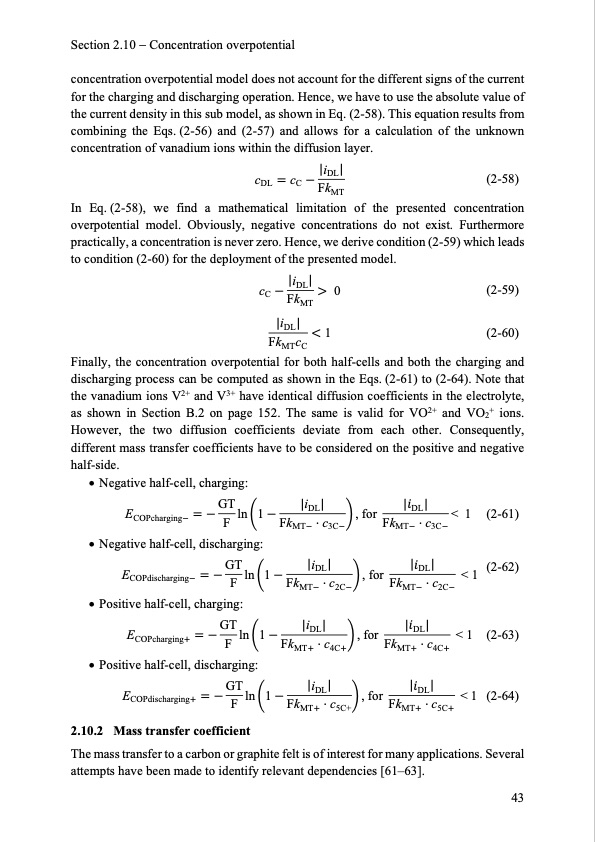
PDF Publication Title:
Text from PDF Page: 051
Section 2.10 Concentration overpotential concentration overpotential model does not account for the different signs of the current for the charging and discharging operation. Hence, we have to use the absolute value of the current density in this sub model, as shown in Eq. (2-58). This equation results from combining the Eqs. (2-56) and (2-57) and allows for a calculation of the unknown concentration of vanadium ions within the diffusion layer. cDL cC |iDL| (2-58) FkMT In Eq. (2-58), we find a mathematical limitation of the presented concentration overpotential model. Obviously, negative concentrations do not exist. Furthermore practically, a concentration is never zero. Hence, we derive condition (2-59) which leads to condition (2-60) for the deployment of the presented model. cC |iDL| 0 (2-59) FkMT |iDL| 1 (2-60) FkMT cC Finally, the concentration overpotential for both half-cells and both the charging and discharging process can be computed as shown in the Eqs. (2-61) to (2-64). Note that the vanadium ions V2+ and V3+ have identical diffusion coefficients in the electrolyte, as shown in Section B.2 on page 152. The same is valid for VO2+ and VO2+ ions. However, the two diffusion coefficients deviate from each other. Consequently, different mass transfer coefficients have to be considered on the positive and negative half-side. Negative half-cell, charging: ECOPcharging GTln1 |iDL| ,for |DL| FkMT ⋅ c3C < 1 (2-61) (2-62) (2-63) (2-64) F FkMT ⋅ c3C Negative half-cell, discharging: ECOPdischarging GT ln 1 F |iDL| FkMT ⋅ c2C , for |DL| FkMT ⋅ c2C < 1 < 1 < 1 Positive half-cell, charging: ECOPcharging GT ln 1 |iDL| FkMT ⋅ c4C , for |DL| FkMT ⋅ c4C F Positive half-cell, discharging: ECOPdischarging GT ln 1 |iDL| F FkMT ⋅ c5C+ 2.10.2 Mass transfer coefficient , for |DL| FkMT ⋅ c5C The mass transfer to a carbon or graphite felt is of interest for many applications. Several attempts have been made to identify relevant dependencies [61–63]. 43PDF Image | Model-based Design Vanadium Redox Flow Batteries

PDF Search Title:
Model-based Design Vanadium Redox Flow BatteriesOriginal File Name Searched:
10-5445IR1000070670.pdfDIY PDF Search: Google It | Yahoo | Bing
Salgenx Redox Flow Battery Technology: Salt water flow battery technology with low cost and great energy density that can be used for power storage and thermal storage. Let us de-risk your production using our license. Our aqueous flow battery is less cost than Tesla Megapack and available faster. Redox flow battery. No membrane needed like with Vanadium, or Bromine. Salgenx flow battery
| CONTACT TEL: 608-238-6001 Email: greg@salgenx.com | RSS | AMP |